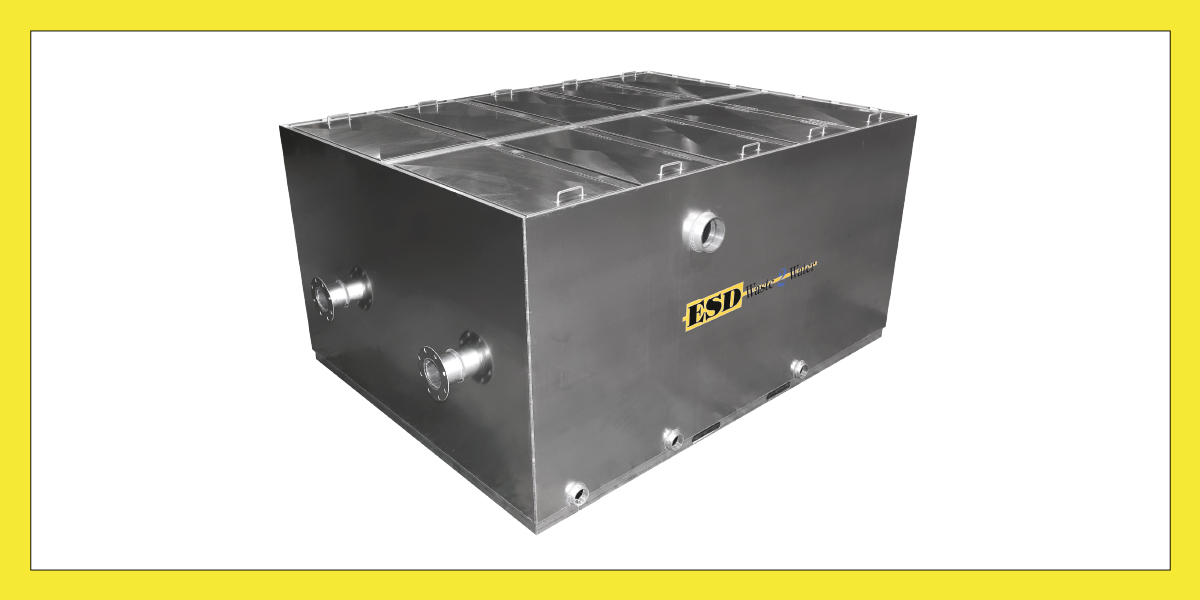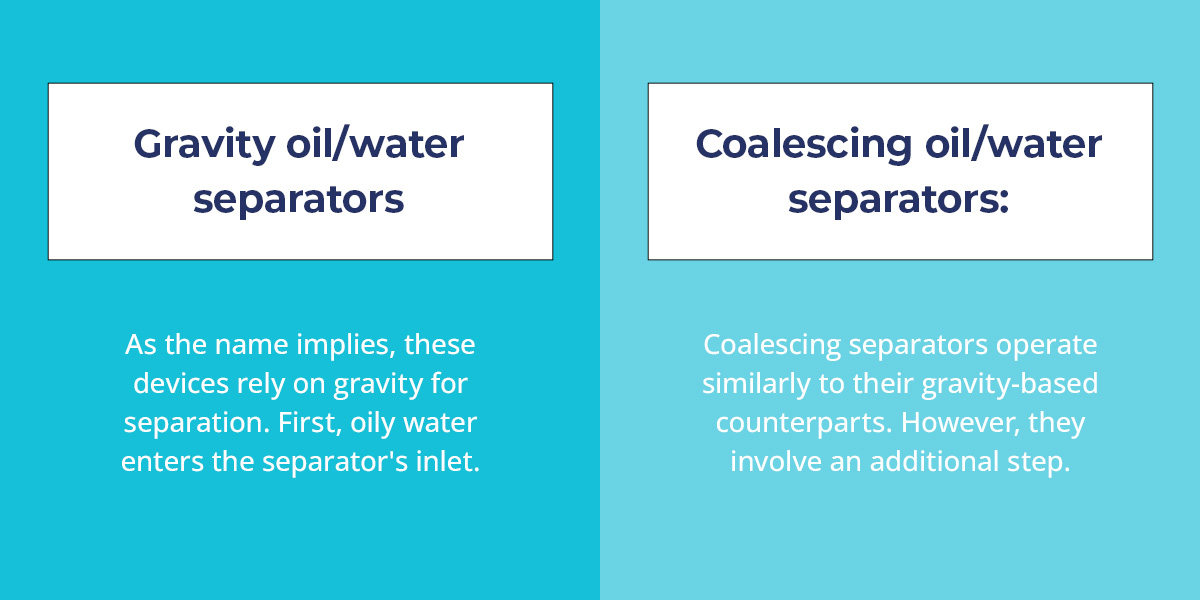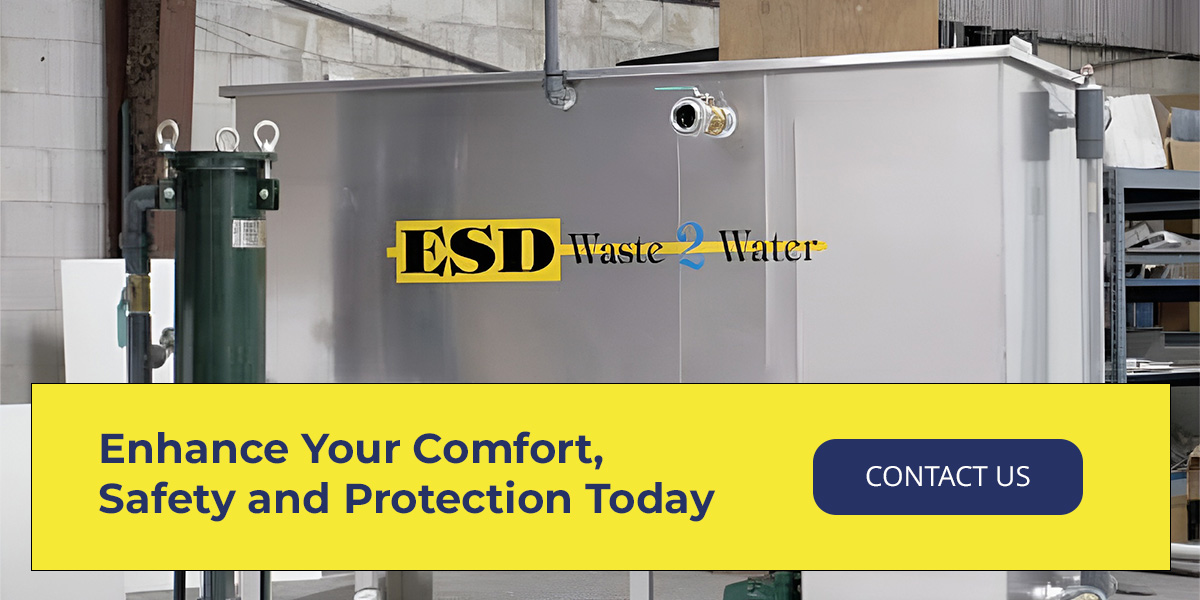
Many industrial processes contaminate wastewater with oil and grease. These include vehicle and equipment washdowns, aircraft fueling, power generation, and more. Oil is an environmental hazard, so it must be separated and removed from the water before it can be safely discharged.
That’s where oil/water separators come in. These are valuable pieces of equipment for:
- Preserving the environment.
- Staying compliant with disposal regulations.
- Making operations simpler and more efficient.
Here’s your complete guide to oil/water separators. We’ll cover how they work, the different types, cleaning tips and more.
What Is an Oil/Water Separator?
Oil is lighter than water, so it naturally floats to the surface. However, small droplets and particles can get left behind when wastewater is ridden with contaminants like grease and oil.
An oil/water separator is a device that separates oil and suspended solids from industrial wastewater. It is typically used for oil spill situations and facilities that handle large volumes of oil, such as:
- Oil refineries.
- Chemical and petrochemical plants.
- Natural gas processing plants.
- Petroleum handling facilities.
Additionally, businesses outside of the oil and gas sector can benefit from oil/water separators. Food processing and storage facilities, car repair shops, and construction sites all create significant quantities of grease and oil.
Oil/water separators operate by flotation. They use oil’s natural buoyancy to bring solids to the surface and trap these particles. These units eliminate harmful oil particles, making the wastewater safe to release into sewer systems.
Types of Oil/Water Separators

Oil/water separators can fall into different categories depending on how they operate. Here are two standard types of oil/water separators and how they work:
- Gravity oil/water separators: As the name implies, these devices rely on gravity for separation. First, oily water enters the separator’s inlet. A baffle decreases the water turbulence, and most solids settle to the bottom of the oil/water separator. As wastewater travels through the unit, small drops of oil rise to the top of the water. The separator uses a second baffle to prevent these droplets from exiting. The remaining solids settle to the bottom.
- Coalescing oil/water separators: Coalescing separators operate similarly to their gravity-based counterparts. However, they involve an additional step. Water and oil also flow through oleophilic media, allowing drops of oil to bind — or coalesce — on the media’s surface. This blending process allows the droplets to become larger and more buoyant. As a result, they can float to the surface faster and separate from water more easily.
How Is Oil Separated From Wastewater?
Oil/water separators leverage the gravity difference between these substances to separate oil and water into their individual elements.
Wastewater passes through a filtration system to remove large solids. It is then funneled into the oil/water separator, where it travels through a series of chambers. These chambers separate oil, water and sludge into different spaces. The heaviest suspended solids and sludge sink to the bottom.
Oil particulates spread over the surface as the wastewater flows through the chambers. These particles bind and create larger, more buoyant deposits so more oil can separate and rise to the water’s surface. Additional wastewater is left in the middle layer.
Once this separation process is complete, the oil is easy to skim off the top. Oil/water separators remove the majority of oil and sludge from the wastewater, preparing it for further treatment and decontamination.
Who Needs an Oil/Water Separator?
Many industrial facilities seek more efficient solutions to separate water and oil. From food processors to mines and construction sites, various industries rely on oil/water separators. Here are some examples of where oil/water separators are used:
- Military facilities: This industry deals with various industrial and maintenance operations for combat readiness. These activities involve vehicle wash racks, oil storage and grease racks, which contaminate water with grease and oil. Federal law requires military facilities to adhere to certain water cleanliness standards. They must take the necessary measures to separate oil from water.
- Construction sites: Washing and cleaning heavy equipment results in grease-suffused water. Therefore, oil/water separators are a must in the construction and heavy equipment industry. These devices are also critical in rental yards that involve the heavy-duty cleanup of cars, trucks and other vehicles.
- Golf courses: Various equipment is washed down at these sites regularly, such as golf carts and commercial mowers. These washdown activities yield oil and grease. Golf courses must comply with environmental guidelines to prevent contaminants from penetrating natural water sources.
- Food processing centers: These facilities produce wastewater with contaminants like solid food, oil and grease. Food and beverage processors can remove these particles using oil/water separators.
- Oil and gas production plants: Naturally, oil and gas manufacturing plants generate considerable oil during production. Oil/water separators help them comply with stringent wastewater regulations.
How to Clean an Oil/Water Separator
Oil/water separators require regular draining and cleaning to function properly. Generally, you should have your oil/water separator inspected once or twice a year and have it cleaned once excess debris buildup occurs. Compared to other equipment that requires frequent attention, oil/water separators tend to be more self-sufficient and offer longer service intervals.
To clean the oil/water separator, the maintenance provider will shut off the influent water to the separator and open the cover. Then, they will remove and dispose of any oil per the appropriate guidelines and drain the water from the device. They also might measure and write down the depth of the leftover solids. This measurement can serve as a framework for scheduling future cleanings and maintenance.
Your maintenance provider will clean the oil/water separator’s media plates, either by removing them or leaving them in the device. Then, they will reinstall the media plates, and the cleaning process is complete.
How to Maintain an Oil/Water Separator
Your oil/water separator’s surrounding environment and climate can impact its performance. To maintain peak efficiency, the system should match the estimated humidity rates in the area.
Additionally, make sure you schedule routine oil/water separator cleaning and maintenance. A professional should perform these tasks for the best results.
Choose ESD Waste2Water for Quality Oil/Water Separators
At ESD Waste2Water, Inc., we manufacture a full line of above-ground oil/water separators. We design these products to remove grease, oil, oil-coated solids and light petroleum products from wastewater. Our separators are also portable, making them simple to transport between sites.
Whatever your unique operations and industry needs, ESD Waste2Water has an oil/water separator for you. Browse our selection of oil/water separators and request a quote today. You can also contact us with any questions about finding the right product for your facility.


